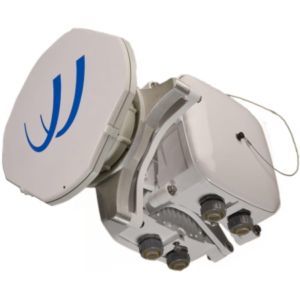Recently, it became known that there is a private, mysterious network stretching between London and Frankfurt that is twice as fast as the normal Internet. The connection, provided by a series of microwave dishes on masts, was completely secret to anyone but one company. Only when a competitor completed its own microwave link between the two cities, the first company revealed that it too had a link between the cities in order to get a share in this potential market.
Similar stories can be found all over the world, but because these networks are privately owned, and because they are often used by financial groups trying to find an edge on the stock market and eke out a few extra billions, you have to investigate hard to find them.
Microwave networks is not a brand new technology. Back in the middle of the previous century there were microwave radio links in the USA and the UK, which carried everything from television and telephone to national defence data. It was cheaper to deploy a microwave network than run cables, and the link capacity was greater than other copper-wire technologies at the time. The weakness of microwave networks, however, is the fact that their high-frequency signals are highly directional and need line of sight between each base station. Also, high-frequency signals distort severely when travelling through rain, cloud, or any other ‘veil’—an effect usually referred to as “rain fade”
That is why microwave links were replaced or augmented with more reliable and resourceful optical fibre.
By now, fibre has mostly superseded microwave for trunk network connections. Microwave networks are nevertheless still widely used, and the underlying technologies are being actively developed. Nowadays they are mostly used to connect geographically remote areas to the Internet or for special applications, such as private financial networks.
One of the reasons microwave networks are still in use is that with the own network connection, it is easier to provide security, quality of service, bandwidth, and other business-relevant factors.
Another reason is that microwave networks can have lower latency than fibre, which can be really fast over short links, but starts lagging over longer distances.
Laying a fibre network is very expensive, as you have to dig hundreds miles of trenches, or lease access to infrastructure ducts. That is why, for example, most of the terrestrial fibre networks are run alongside existing roads and railways.
So, for instance, if the distance between two cities is 640 km, a radio signal travelling through the air at just under the speed of light (299,700km per second) would cover that distance in 2.126 milliseconds. Through a glass or plastic fibre, where light has to bounce along the refractive index rather than travel in a straight line, the speed of light is reduced to around 200,000km/s, resulting in a theoretical minimum latency of 3.186 milliseconds.
In reality though, the fibre network is not just a single straight piece of fibre. First, the packet of data might bounce around a few times until it gets to the right router for its intercity journey. Along the way, there are other routers and repeaters. And on the other end, the destination server may be a few hops away, too. All factors considered, and the average latency between two servers gets actually closer to 17 milliseconds.
On the other hand, a private microwave network may have a latency of about 4.2 milliseconds. However, the newest connections are still secret and their exact latencies are unknown. That is why businesses and financial institutions which absolutely must have the fastest connection opt for microwave links instead of fibre.
Building a point-to-point network
From the point of view of infrastructure, microwave networks consist of rows of masts with two transceivers at the top, each pointing in opposite directions. The distance between the masts depends on geography, but the average is about 40-65 km. The actual maximum distance is determined by each transceiver’s height above ground level, radio frequency licensing restrictions, and the lay of the land.
In general, laying a new run of fibre is cheaper than rolling out your own private microwave network, but that only works if there is already a duct between the two points that you are trying to connect.
Beyond microwaves
Lately, some networking companies have also been experimenting with lasers (i.e. free space optics) rather than microwaves for point-to-point links.
The current prototypes of laser-based networks are not necessarily much faster—latency can be reduced slightly, bandwidth is about the same —and the super-high-frequency (~200,000GHz) signals are severely attenuated by rain and cloud. The attenuation can be partly counteracted with adaptive optics, where the receiver attempts to deform its shape to compensate for distortions in the signal, but you still need a fail-over link—a backup microwave, millimetre wave, or fibre cable—in case of bad weather.
Point-to-point millimetre wave networks, which use the block of spectrum above microwaves (~30GHz to 300GHz), are growing in popularity—but in many cases they are just a drop-in alternative with slightly higher throughput and worse bad-weather performance than microwave.
This is the review of an article.
Source: arstechnica.co.uk





